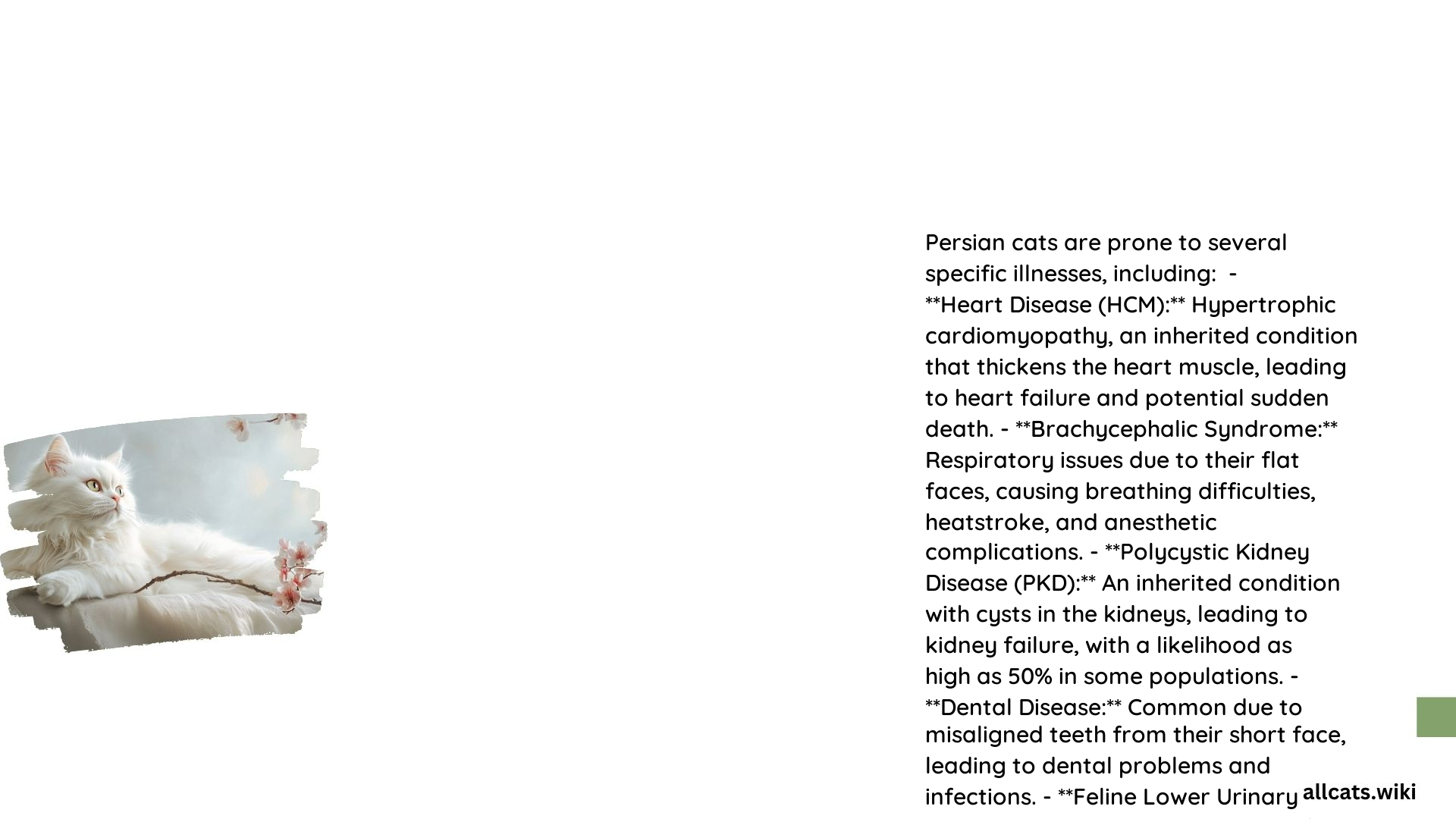Persian cats are prone to several health issues, many of which are related to their unique physical characteristics and genetic predispositions. From breathing difficulties to kidney disease and heart problems, these felines face a range of potential health concerns that require vigilant care and management.
Brachycephalic Airway Syndrome

One of the most common health issues affecting Persian cats is Brachycephalic Airway Syndrome. This condition is caused by the breed’s flat face and short nose, which lead to narrow nasal passages, an elongated soft palate, stenotic nares (narrowed nostrils), a hypoplastic trachea (underdeveloped windpipe), and everted laryngeal saccules. These anatomical features make breathing difficult for Persian cats, leading to symptoms such as mouth breathing, trouble breathing, coughing, snorting, trouble eating, and vomiting.
In mild cases, management at home may be sufficient, but in more severe cases, surgery may be required to alleviate the breathing difficulties.
Polycystic Kidney Disease (PKD)

Polycystic Kidney Disease is another prevalent health concern in Persian cats. This inherited condition causes cysts to develop in the kidneys, present from birth and growing over time, ultimately leading to kidney failure. Symptoms of PKD include increased thirst and urination, decreased appetite, weight loss, vomiting, and lethargy.
Approximately 40% of Persian cats are affected by PKD, with symptoms typically appearing around 7 years of age. While there is no cure for this condition, management through medications, diet, and regular ultrasounds can help alleviate the symptoms and slow the progression of the disease.
Hypertrophic Cardiomyopathy (HCM)
Hypertrophic Cardiomyopathy is an inherited heart disease that affects Persian cats. This condition causes the heart muscle to thicken, reducing blood flow and potentially leading to heart failure. Symptoms of HCM include labored breathing, hind leg paralysis, and collapse.
While there is no cure for HCM, medications can be used to help manage the symptoms and slow the progression of the disease.
Dental Disease
Persian cats are prone to dental disease due to their short face and misaligned teeth, which make chewing difficult. This can lead to mouth pain, poor appetite, lack of grooming, bad breath, and infection. Regular dental care, including brushing teeth, is crucial to prevent dental disease in Persian cats.
Eye Problems
The exposed cornea of Persian cats due to their facial structure can lead to various eye problems, such as corneal sequestra (dead tissue on the cornea) and persistent discharge from the eyes due to malfunctioning tear ducts. Regular cleaning of the eyes and face is essential to prevent infections.
Skin and Fur Issues
Persian cats are also prone to skin and fur issues, such as skin folds prone to bacterial and fungal infections, and grooming difficulties leading to matting and skin irritation. These issues are often related to the breed’s genetic predispositions and can be exacerbated by grooming neglect. Regular grooming and checking skin folds for infections are crucial for maintaining the health and well-being of Persian cats.
Other Health Issues
In addition to the conditions mentioned above, Persian cats may also be susceptible to other health issues, such as:
- Thromboembolism: Blood clots forming in the heart and lodging in major arteries, leading to sudden loss of use in the rear legs and tail.
- Feline Lower Urinary Tract Diseases (FLUTD): Discomfort leading to urination outside the litter box.
- Feline Infectious Peritonitis (FIP) Susceptibility: Persians are more at risk for developing FIP, which causes vasculitis and fluid build-up in the abdomen or chest.
Preventative Care and Recommendations
To help manage and prevent the health issues that Persian cats are prone to, it is essential to provide them with the following:
- Regular Veterinary Check-ups: Annual check-ups are crucial to monitor for early signs of these conditions and catch any issues before they become more severe.
- Genetic Testing: For conditions like PKD and HCM, genetic testing can help identify predispositions early, allowing for proactive management.
- Dietary Care: A balanced diet is essential, as poor-quality food can exacerbate health issues. A high-quality diet is recommended for Persian cats.
- Environmental Factors: Keeping the environment cool and humid-free can help manage breathing issues associated with brachycephalic syndrome.
Statistics and Prevalence
According to the available data, nearly two-thirds of Persian cats suffer from at least one health condition, indicating a significant welfare concern for this breed. Additionally, the average lifespan of a Persian cat is approximately 13.5 years, which is shorter than many other cat breeds due to the prevalence of health issues.
In conclusion, Persian cats are prone to a wide range of health problems, many of which are directly related to their unique physical characteristics. By understanding these issues and providing proactive care, owners can help their Persian cats live healthier and more comfortable lives.
